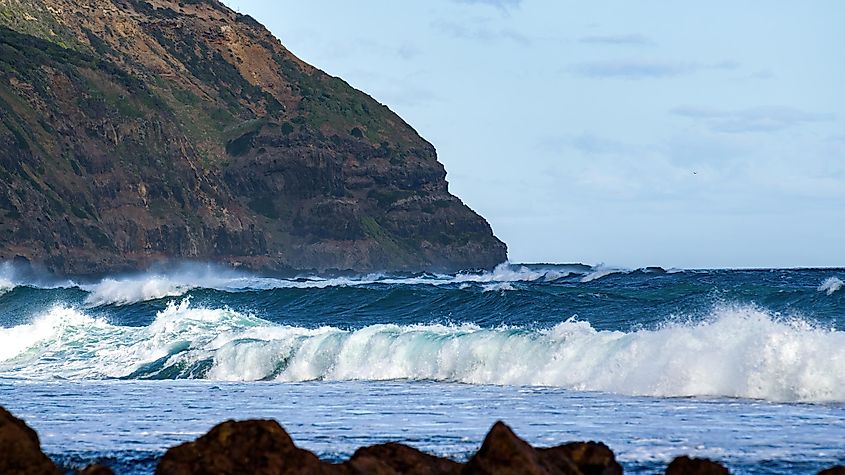
Waves
While standing on a sea beach, one can observe that the water is physically moving toward the shore and rolling inwards and outwards. These are called water waves, formed by the wind moving across the free surface of a body of water creating disturbances. The waves, however, do not cause the water to move but are actually the movement of energy through the water. Water waves are indeed a treat to the eyes as they are in a continual set of motion, attracting surfers and beachgoers to the otherwise mundane sea beaches. Although the large and calm waves that come at frequent intervals charm the surfers and beachgoers, the giant rogue waves cause shipwrecks and result in several fatalities. Moreover, some abnormal natural phenomena like underwater landslides, volcanic eruptions, and earthquakes can create enormous waves termed tsunamis, leading to widespread damage to coastal environments and human habitations.
Geography Of Water Waves

A wave is defined as a disturbance on the surface of a water body that moves in a forward motion. Water waves are generally surface waves or deformations on the sea surface that are a mixture of longitudinal and transverse waves formed by the interaction between the Sun, the Earth, and the Moon. These deformations disseminate with the wind speed, whereas the water molecules stay at the same position. The waves moving towards the shore carry the energy from the wind offshore. A wave makes the surface water move in a simple harmonic motion as wave crests and troughs. Crests are the highest points of a wave, while troughs are the lowest points. For progressive waves, the crests and troughs move at a steady speed in a perpendicular direction to themselves. No such progression is, however, observed for standing waves. Often at the beaches, we can see waves traveling in groups which are referred to as wave trains.
Many factors determine the formation of waves. These include the wind speed; the undisturbed distance of open water over which the wind is blowing without any significant direction change; the breadth of the area impacted by the wind fetch; the duration of wind flow over the water; and the depth of the water body. It is to be noted that ocean waves can travel large distances before they reach the shores. Depending on the water depth, wind speed, wind fetch, and duration of blowing wind, the wind-generated waves can range in size from small ripples to waves having a height of 100 ft.
Types Of Waves
Several distinctive types of waves develop over time. Some of these types have been discussed below.
Capillary Waves

Often referred to as ripples, capillary waves move along a fluid’s phase boundary and are greatly influenced by the effects of surface tension. This type of wave is quite common in nature, having a wavelength of less than a few centimeters and a phase speed of about 0.2 to 0.3 meters per second.
Gravity Waves
This type of wave is generated by gravitational forces acting on a fluid medium and develops when a fluid is displaced from an equilibrium position. The gravity waves that are seen on the air-sea interface are referred to as surface gravity waves, while the gravity waves that are produced within water bodies are known as internal waves.
Swell Waves

Swell waves are deeper waves formed when a large amount of energy builds up beneath the ocean's surface, sustained by wind strength and duration of wind blow over a fetch of water. Often called surface gravity waves, swell waves move along the air-water interface under the influence of gravity and have comparatively longer wavelengths. Occasionally, most severe storms result in the formation of swells that are longer than 700 m.
Seiche Waves
Seiche waves are standing waves observed in fully or semi-enclosed water bodies like lakes, bays, reservoirs, harbors, swimming pools, and seas. Seiche waves are formed by resonances in water bodies often disturbed by seismic activities or meteorological disturbances. This type of wave was first scientifically observed in Lake Geneva by Francois-Alphonse Forel - a renowned Swiss hydrologist, in 1890.
Seismic Waves

Underwater landslides, earthquakes, large artificial explosions, faulting of the seafloor, and volcanic eruptions cause this type of wave. Seismic waves have a wavelength of about 120 miles and generate massive tsunamis. Seismologists record seismic waves using various instruments like seismometers, accelerometers, and hydrophones.
Tidal Waves

Tidal waves are periodically occurring waves caused by the gravitational interactions between the Moon, the Earth, and the Sun. The height of the tidal wave is usually determined by the gravitational force of the moon, which makes the waves sway up and down. Tidal waves are experienced daily in the coastal regions, and their effect is more pronounced along narrow bays and estuaries.
Rogue Waves

Also referred to as monster waves, these abnormally large and unpredictable surface waves are highly dangerous even for the biggest ships. Oceanographers define rogue waves as having more than double the significant wave height. The rogue waves have great force and appear suddenly without warning. Often these waves appear in the opposite direction to that of the prevailing regular waves.
Nevertheless, many prominent coastal landforms have been formed by erosion and deposition activities of the sea waves. The waves are also critical for the livelihoods of coastal communities and for determining the shipping routes. However, at present, due to climate change, unusually large waves are becoming more common with an increase in storms, melting of glacial ice, and rise in sea level.











